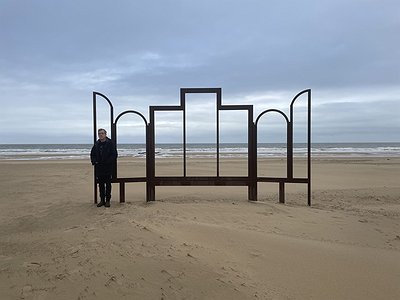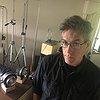Part 1
Name: Jon Leidecker aka Wobbly
Occupation: Multimedia artist, composer, improviser
Nationality: American
Current release: Wobbly's Additional Kids is out June 9th 2023 on Hausu Mountain.
Recommendation: 'Mind And Nature’ is the fastest acting first stop for Gregory Bateson if you’re asking lots of questions about technology and the fate of the world. Olaf Stapledon’s ‘Star Maker’ too.
If you enjoyed this Wobbly interview and would like to stay up to date with his music, visit the official Wobbly homepage.
When I listen to music, I see shapes, objects and colours. What happens in your body when you're listening? Do you listen with your eyes open or closed?
That depends on the physical events involved in making the music. If the performance was automated, and I’m listening to a recording, there’s less to look at — maybe my eyes will be closed. In cases like that, even ambient music tends to send my brain in overdrive; there’s a lot of technology required to make those ‘relaxing’ sounds. Otherwise, my eyes might be open because I want the rest of the supporting details.
I don’t think the brain will ever fully acclimate to the reality of recorded music, the idea that there’s only the sound, only an audience, and no immanent relationship. But when I listen to a recording the Mbuti Pgymies singing the ‘Elephant-hunt Song’, on some level, even if I’m listening to it while checking e-mail … my body hears the sounds of coordinated physical exercise by a group of people trying to physically synchronize themselves as a team, so they can go out and kill something and eat it.
So even as background music, on one level, that’s what’s happening in my body as well.
What were your very first steps in music like - and how do you rate gains made through experience versus the naiveté of those first steps?
I only have this on report, but as a toddler I liked to sit and watch the records spinning while listening. And growing up in the 70’s, I have memories of my Dad’s electronic music collection — things like Carlos and Subotnick and various fun Switched-On cash-ins — precisely because I couldn’t wrap my head around how those sounds were being made.
When I was thirteen, my mom remarried and we moved from Washington D.C. to Contra Costa County in California, and suddenly I was living in a house with a piano, a Casiotone, and two cassette decks, allowing me to record sound-on-sound. Eventually my mom sprang for a cassette four-track and a slightly more flexible synthesizer — though she was already averse to encouraging me too much, because it quickly became the only thing I wanted to do.
According to scientific studies, we make our deepest and most incisive musical experiences between the ages of 13-16. What did music mean to you at that age and what’s changed since then?
All I remember is that listening was not enough — I had to be making it as well, even though it was mortifyingly clear how amateurishly bad my attempts at it were. The second I could, I began making full length albums on cassette, running parallel but irregardless of my record collecting, which at the early stages of ’82 to ’86 would roughly be a path from Devo, Kraftwerk & early Hip Hop Scratch Mixes through to Eno & Faust. That was mostly solo listening — my attempts to share those records with friends rarely clicked.
[Read our Brian Eno interview]
But even if you grow up listening to records in isolation, now it’s clear that it was still social listening, laying down a life map towards all those other people who were also listening alone.
Over the course of your development, what have been your most important instruments and tools and how have they shaped your perspective on music?
The studio is certainly my main instrument, but there’s still nothing like sitting down in front of a piano. And any electronic instruments I end up playing more than twice, from samplers to touchscreen apps, usually have interfaces that let me use what I know from the piano.
When you look at videos of King Tubby or Scientist behind the mixing board, their gestures remind me of a combination of piano playing and conducting — keys and faders feel similar when you’re in the flow. And nothing shapes your perspective on music like a tempered keyboard — that seductive idea that all you have to do to make music is press down on the right combination of buttons?
Electronic music is both a complement and a corrective to that, because you quickly realize just how limiting any one set of buttons can be. You pick an interface, and your sounds come out of its limits.
What, would you say, are the key ideas behind your approach to music and what motivates you to create?
Recordings have deeply impacted our experience of music — they reenforce the idea that music is an object, a thing, a commodity, when it’s not — the recording is not the music. They’re the artifact or the potential for it — they’re like a score, a set of instructions for a speaker, and you can’t hear the same music twice.
Recordings are a tool that, as often happens with tech, get confused with what we’re using them for. So the role of the artist is to be sure you’re using those tools to connect people, not to replace them. And music is a particularly effective way to model how we do that, because it’s so abstract — whenever we’re listening to it, we know it’s more than real. Even through all the pressure for it to commodify itself, it’s always more than a thing.
A lot of this thinking didn’t come into focus until around 2008, when the Museum of Contemporary Art in Barcelona commissioned me to make a podcast about the history of sampling — ‘Variations’ ended up being more of a history of recording technology, how it welded classical and folk together into Popular music, and what it did to all of our ideas about what music is.
Paul Simon said “the way that I listen to my own records is not for the chords or the lyrics - my first impression is of the overall sound.” What's your own take on that and how would you define your personal sound?
That recent book of collected interviews with Maryanne Amacher comes to mind.
She felt Western music overemphasized the importance of melody, mistaking tunes for the core of the work, because they’re what we can transcribe. Amacher thought overtones & timbre weren’t ornamental or subservient, that it was precisely that 3-5k range in the spectrum that is the most important because those are the frequencies that sympathetically resonate the mechanism of the inner ear.
If you’re having a powerfully subjective response to a sound, it’s literally because part of the sound you’re hearing is only going on inside your head. So her music exaggerated that 3-5k range until your inner ear is resonating as loudly as the external sounds, forcing you to notice the physicality of your own ears — your conscious mind becomes aware of how you hear sound.
And it’s initially terrifying — the times I saw her perform, there was always a magic moment where the audience would want to run because they thought it was dangerous, their ears were doing things that normally only happen when sound is damagingly loud. But once they realized it wasn’t dangerous, that panic would melt into total euphoria, people wandering around with these unbelievable smiles on their faces. It was music designed to become part of your own body, but you’re not only a part of it, it’s helping you understand how your own physical body works, just as meditation begins by focusing your attention on your own breath.
In any case — chords and the lyrics are what we value because we have enough in the way of a language to hold them in our memory, but they’re not what’s doing the real work. That’s the ‘overall sound’.
Sound, song, and rhythm are all around us, from animal noises to the waves of the ocean. What, if any, are some of the most moving experiences you've had with these non-human-made sounds? In how far would you describe them as “musical”?
Two hours south of San Francisco is Pinnacles National Monument — the peak is about 2000 feet up, overlooking two interlocking valleys. The acoustics are insane from the peak. And on a good day, you can hear the birds playing the echoes; they’ll give a mid-flight squalk and it’ll have a strong echo, they’ll turn 90 degrees right and the next squalk will have a radically different impulse. And you can watch and see them adjust their flight path and do it again — they were playfully jamming.
Learning their environment, with aesthetic side-effects. I think we’ve all had moments where we hear animal voices just veer off into total expression for the sake of it, just doing it for style. And I’ve had experiences in Lassen where the wind begins filtering the sound of a creek that’s three miles away, and the line between listening for useful information and listening for simple pleasure goes away.
Good luck defining consciousness, but we’re learning more about how large networks of systems make intelligent decisions over extended periods of time, so you don’t need to falsely aestheticize things in order to hear those sounds as an expression, trees don’t need ears to hear themselves fall in the forest.






